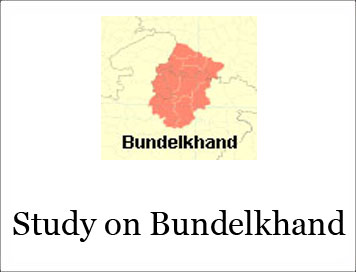Study on Bundelkhand of Planning Commission: Demography - Districtwise analysis
Study on Bundelkhand of Planning Commission: Demography - Districtwise analysis
Districtwise analysis
1 District Chhatarpur :
District Chhatarpur with its population of 11,58,076, has 6 tehsils and 8 blocks. The name of six tehsils are- Gaurihar, Loundi, Naugaon, Chhatarpur, Rajnagar and Bijawar. While all the tehsils have blocks of the same names, only Bijawar tehsil have two more blocks, namely Bada Malhara & Bakswah apart from Bijawar itself. While the blocks deal with only rural population, say the villages, tehsils deal in with both rural and urban populace, which means villages as well as towns (Municipalities and town areas).
The comparison between the blocks of Chhatarpur on basic demographic indicators provides interesting picture. Women contribute 46.12% of the total population of the district Chhatarpur. While the decadel population increased for district has been 30.61%, in most of the blocks it has been lower than the district average, except block Rajnagar where it was recorded as 31.73%. It is interesting to note that block Bakswah has registered a negative decadal population increase. The causes for that need to be explored. Bakswah has also the least population in the district and the lowest density with just 58 people residing in one sq.km area. Bakswah has the highest sex ratio (871) in the district and one of the largest population of Scheduled Tribe i.e. 11.97 % next to the 13.52% of Bijawar block
It is noteworthy that al l the three blocks of Bijawar tehsil, namely Bada Malhara, Bakswah and Bijawar have registered relatively low population increase and are scarcely populated. They have the large concentration of scheduled tribe populationwith Bijawar block having the highest percentage at 13.52. So far as the literacy rate is concerned, it is comparatively lower in these three blocks, the lowest being in block Bijawar with 18.32%.
Blocks Gaurihar and Loundi have highest concentration of SC population in the district. Both of these are among the most literate blocks of the district but what it contrasting in the case of block Gaurihar is that it being the most literate with 34.11% has the least Couple Protection Rate (CPR) in the whole state of MP with just 22.85% of its eligible couples effectively protected against pregnancy.
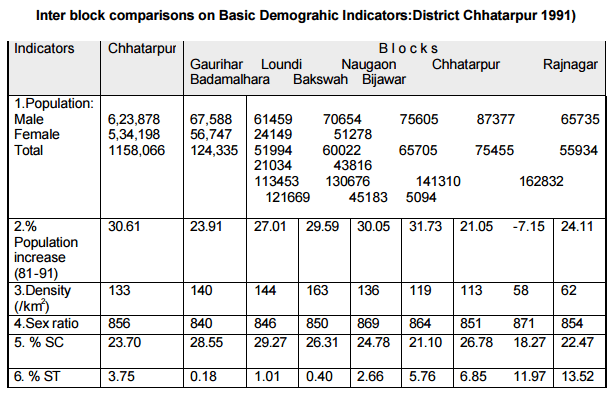

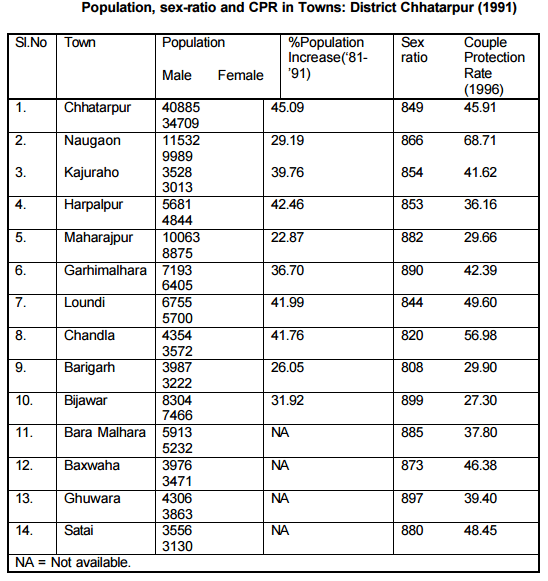
2. District Datia
Datia is the smallest district of MP, in terms of both the area and the population. The two rural blocks, Sewda and Datia are the part of the two tehsils of the same names. These two blocks have shown the percent population increase lower than the district average. Density in block Datia is higher than Sewda. Sex ratio of Datia block is better than sewda. Both the blocks have almost similar percentage (see table 2.6) of Scheduled Caste while block Sewda has a negligible percentage of ST. Literacy rate in block Sewda is slightly better than block Datia and this perhaps is the cause behind a high couple protection rate in block Sewda in comparison to block Datia. District Datia has three towns (see table 2.7), the biggest being Datia itself. Indergarh the smallest town in district, has registered a high percentage of Couple Protection Rate, the exact figure being 75.73 % which is very high in comparison to other towns of the district.
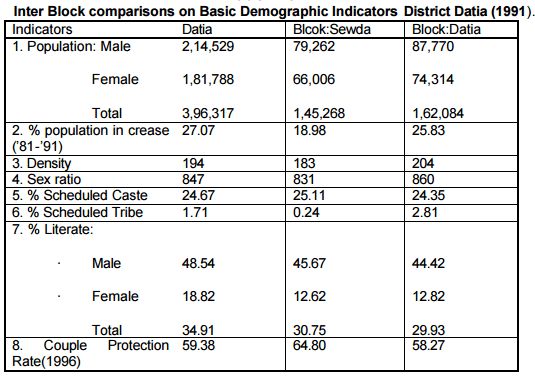
3. District Panna.
District Panna has five tehsils and five blocks. Each tehsil has one block of the same name. Among the blocks, Ajaigarh has shown the highest decadal population increase with 28.32 %, followed by Shahnagar with 27.36 %. Ajaigarh is also the most densely populated block of the district with its density at 172 persons per sq.kilometer. Block Shahnagar has the lowest density i.e. 75, and has the highest percentage (28.70) of ST population in the district. Ajaigarh has the lowest percentage of ST in the district (see table 2.8), lowest sex ratio (866) alongwith blocks Shahnagar, lowest percentage of literacy (20.97) followed by block Shahnagar (22.62%) and the lowest percentage of couple protection rate with only 40.09 % of eligible couples protected against pregnancy
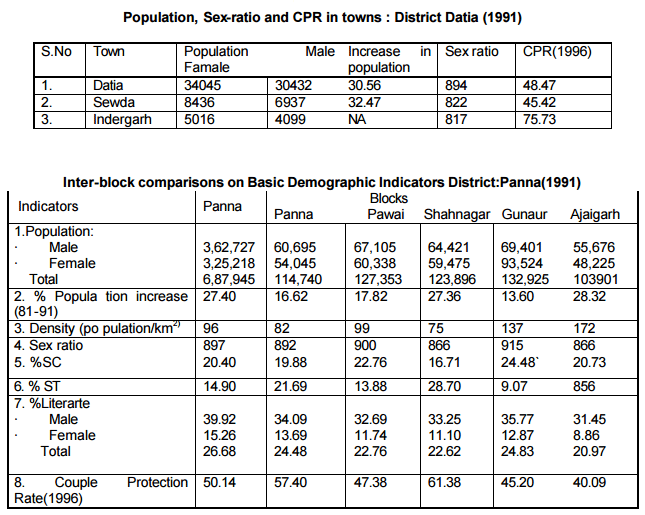
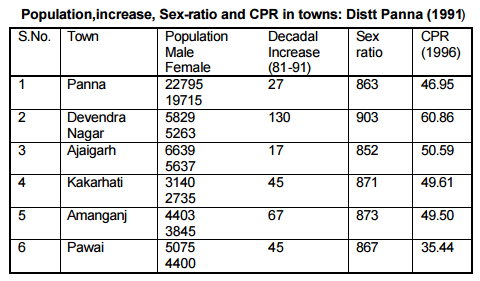
Blocks Shahnagar, Panna and Pawai have large concentration of Scheduled Tribe population while block Gunaur has the highest percentage of SC population, i.e. 24,.48%.Block Shahnagar has interestingly registered the highest couple protection rate with 61.38% followed by block Panna with 57.40%. District Panna has six towns (see table 2.9). Among these, Devendranagar has shown the highest population increase with 130%. It has also the best sex-ratio in comparison to other towns of the district. It is worth noting here that this town is growing as a centre of sexworkers. Devendranagar has also registered the highest couple protection rate with 60.86% of its eligible couples protected against pregnancy.
4. District-Satna.
District Satna has five tehsils and eight blocks. Tehsil Raghurajnagar comprises of blocks Majhgawa and Sohawal, tehsil Rampur Baghelan comprises of only one block of the same name, tehsil Nagod comprises of two blocks namely Nagod and Uchhehara, tehsil Amarpatan also has two blocks namely Amarpatan and Ramnagar and tehsil Maihar comprises of only one block of the same name. Population-wise, block Maihar is the largest block of the district, followed by Majhgawa and Rampur Baghelan. Decadal population increase has also been the highest (28.48%) in block Maihar, followed by block Nagod and Uchehara (see table 2.10). Density of population is highest (204) in block Amar Patan, closely followed by block Ramnagar with 194. These two densely populated blocks also have the best sex-ratio in the district. Block Majhgawa has the least density (107) and the lowest sex ratio (895) in the district. The percentage of SC is highest (26.29) in block Sohawal, closely followed by block Nagod with 24.51%. Block Ramnagar has the lowest percentage of SC (13.28%), but the highest percentage of ST (24.80%) in the district. Blocks Maihar, Uchehara and Majghawa have considerable population of ST in the district. Among all the Blocks of district Satna, literacy percentage of block Maihar is lowest with overall 26.62%, followed by blocks Majghawa and Ramnagar with their respective figures of 28.11 and 28.31%. Block Sohawal has the highest literacy rate with 36.30%, which is little higher than the district average. Couple Protection Rate (CPR) is highest in block Ramnagar, where 55.22% of eligible couples are protected against the pregnancy. Block Rampur Baghelan closely follows with the figures of 52.24% coverage. CPR is the lowest in block Majhgawa with 29.97 % coverage, followed by both Maihar with 35.64% coverage. District Satna has eleven towns. Among them, towns Satna and Madhavgarh are growing fast in comparison to other towns. Kothi has the most favourable sex-ratio with figure 927 while town Satna has the least with figure 850. The town Jaitwara, which has registered the least decadal increase in population, i.e. 22.70%, has also shown logically highest couple protection rate with the figure of 73.86%.(see table 2.11). Madhavgarh, which is growing fast, has the lowest couple protection rate with just 25% of eligible couples protected effectively against pregnancy
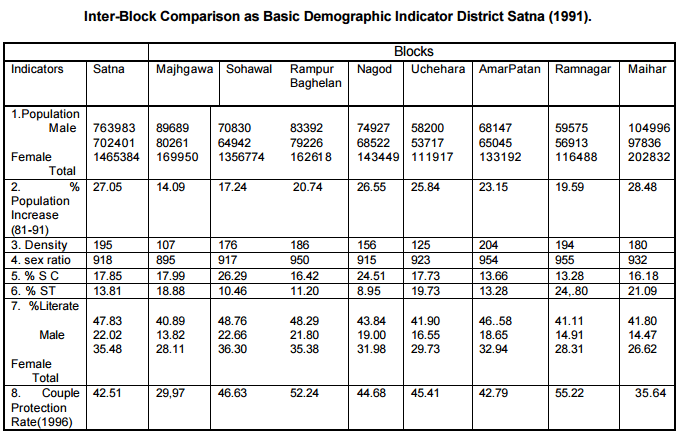
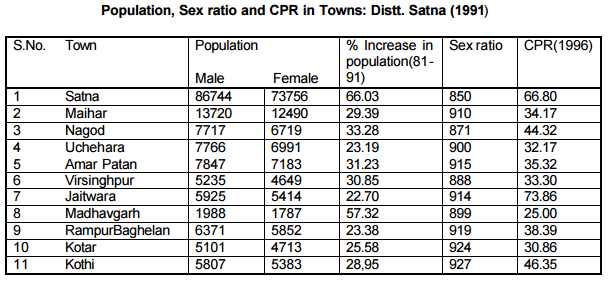
5 District Tikamgarh.
District Tikamgarh is divided into five tehsils and six blocks. Tehsils Tikamgarh, Baldeogarh, Jatara, Newari and Prithivipur have the blocks of the same names while another block named Palera is the part of Jatara tehsil. Population-wise, block Jatara is the largest and Prithivipur is the smallest block in the district (see table 2.12).But Prithivipur has shown the highest percentage of population increase during 1981-1992, closely followed by block Palera. Block Newari had the lowest percentage of population increase during the last centres decade. But Newari is the most densely populated block with 208 persons residing in one sq.km area. Prithivipur has the lowest density (107) of population, but has the most favourable sex ratio (907) in comparison to other blocks. Palera has the least favourable sex ratio (855) in the district.
Block Palera has the highest concentration of SC population i.e. 27.07% of the total population of the block. Newari also has a high concentration (26.02%) of SC. Block Newari has the highest percentage of literacy i.e. 32.60%, from among all the blocks of the district. The lowest is in Baldeogarh. Block with just 20.93% of its population literate. The overall literacy rate in all the blocks of Tikamgarh is relatively poor. Couple Protection Rate (CPR) is highest in Newari Block, where 66.35% of eligible couples are effectively protected against pregnancy. Newari is the block which has close linkages with the areas of Uttarpradesh and has progressive farming of cash crops and vegetables. So, the block is comparatively better literacy rate as well as CPR shows that the block’s progressive. Prithivipur, too has a high CPR i.e. 63.15%. Baldeogarh and Jatara are lagging behind in CPR in comparison to other blocks.
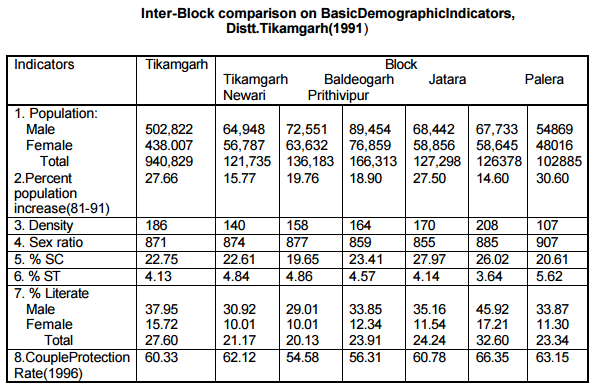
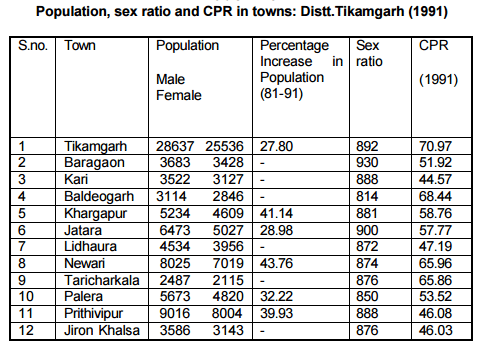
5 District Tikamgarh.
District Tikamgarh is divided into five tehsils and six blocks. Tehsils Tikamgarh, Baldeogarh, Jatara, Newari and Prithivipur have the blocks of the same names while another block named Palera is the part of Jatara tehsil. Population-wise, block Jatara is the largest and Prithivipur is the smallest block in the district (see table 2.12).But Prithivipur has shown the highest percentage of population increase during 1981-1992, closely followed by block Palera. Block Newari had the lowest percentage of population increase during the last centres decade. But Newari is the most densely populated block with 208 persons residing in one sq.km area. Prithivipur has the lowest density (107) of population, but has the most favourable sex ratio (907) in comparison to other blocks. Palera has the least favourable sex ratio (855) in the district.
Block Palera has the highest concentration of SC population i.e. 27.07% of the total population of the block. Newari also has a high concentration (26.02%) of SC. Block Newari has the highest percentage of literacy i.e. 32.60%, from among all the blocks of the district. The lowest is in Baldeogarh. Block with just 20.93% of its population literate. The overall literacy rate in all the blocks of Tikamgarh is relatively poor.
Couple Protection Rate (CPR) is highest in Newari Block, where 66.35% of eligible couples are effectively protected against pregnancy. Newari is the block which has close linkages with the areas of Uttarpradesh and has progressive farming of cash crops and vegetables. So, the block is comparatively better literacy rate as well as CPR shows that the block’s progressive. Prithivipur, too has a high CPR i.e. 63.15%. Baldeogarh and Jatara are lagging behind in CPR in comparison to other blocks.

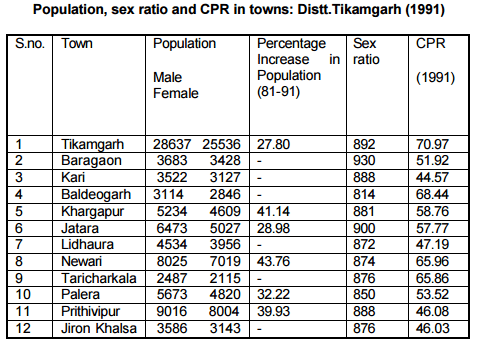
District Tikamgarh has twelve towns. Five of them have been given the status of town after 1981. They are baragaon, Kari, Baldeogarh, Lidhaura and Jiron Khalsa. Towns of Tikamgarh district have comparatively unfavourable sex ratio, the highest being 930 in Baragaon town, followed by 900 in Jatara. (see table 2.13). Couple protection rate (CPR) is high in towns Tikamgarh (70.97), Baldeogarh (68.44%), Newari (64.96%) and Taricharkala (65.86%). The lowest CPR is in town Kari where only 44.57% of eligible couples are effectively protected against pregnancy.
The major findings emerging from the demographic analysis are:
-
Out of the total population in the state of MP in 1991, women constitute around 48.22 % with a sex-ratio of 931, which has decreased from the figure in 1981, but is still better than the national average of 927 in 1991.
-
Exponential Growth Rate, Crude Birth Rate, Crude Death Rate, Total Fertility Rate and Infant Mortality Rate of MP are all higher than that of national average.
-
The Couple Protection Rate(CPR) of the state(1991) is lower than the Indian average.
-
Satna has the largest population, followed by Chhatarpur, Tikamgarh, Panna and Datia respectively. Datia is the smallest district of MP, both in terms of area and population.
-
District Chhatarpur shows the highest decadal increase in the population, followed by Tikamgarh. Districts adjoining Chhatarpur, like Tikamgarh in the west and Panna in the east, have shown higher decadal growth rate\ than the farther districts, like Datia and Satna. The Total Fertility Rate (TFR) also shows the similar trend.
-
District Satna is most densely populated (195), followed by Datia and Tikamgarh. Panna has the lowest density (96). Only Panna and Chhatarpur have the density which is lower than the state average.
-
All the districts have a lower percentage of urban population in comparison to state average. The highest (22.45%) is that of District Datia and the lowest (13.02%) of district Panna.
-
Sex ratio of all the districts is lower than the state average. This hints at the status of women in the region. Satna has the highest sex-ratio (918) while Datia has the lowest (847). It is more favourable to women towards the east, that is in the districts of Panna and Satna than towards the west, near Chambal region which is close to Datia.
-
Crude Birth Rate (CBR) is very much high for each district in comparison to the state average. It is higher in Chhatarpur, Panna and Tikamgarh than Satna and Datia.
-
Infant Mortality Rate in all the districts is much higher than the state average. It is highest in Tikamgarh (195)followed by Panna (185)and Chhatarpur (182).
-
Percentage of population of age-group 0-14 yrs is 38.1 for MP, while it is higher in the case of all the concerned districts, in which it varies between 41.36 to 42.52 percent. This shows that quite a considerable population is dependent upon the other half of working population.
-
Couple Protection Rate (CPR) for the state is 53.45 % (calculated in 1996). Districts Tikamgarh (60.33%) and Datia (59.38) have CPR which is well ahead of state-average while other districts have it well below state-average. District Chhatarpur has the lowest CPR (39.989%) in the state of MP
-
In the district of Chhatarpur, three blocks of Bijawar Tehsil, namely, Bada Malhara, Bakswah and Bijawar, have registered relatively low population increase and are scarcely populated. Block Bakswah has shown even negative decadal population increase. These block have the large concentration of scheduled tribe population with Bijawar having the highest (13.52%). Literacy rate is comparatively low in these three blocks, the lowest in Bijawar (18.32%).
-
In district Chhatarpur, blocks Gaurihar and Loundi have highest concentration of scheduled caste population. What is interesting with block Gaurihar is that it is most literate block (34.11%) of the district but has the least couple protection rate (22.85%) in the state of MP.
-
In district Panna, block Ajaigarh singularly stands out as the most backward block. Ajaigarh has the highest decadal population increase (28.32%), most dense population (172 persons per s.km), lowest sex ratio (866), lowest literacy rate (20.97%), lowest %ge of ST (8.56%) and the lowest %ge of couple protection rate (40.09%).
-
In district Panna, blocks Shahnagar, Panna and Pawai have large concentration of ST population while block Gunaur has the highest percentage of SC population (24.48%).
-
In district Satna, block Majhgawa has lowest decadal population increase (14.09%) and lowest density of population (107) while it also has lowest sex ratio (895), one of the lowest literacy rate (28.11) and the lowest couple protection rate (29.97). Majhgawa has almost equal percentage of SC and ST population in the block.
-
In district Satna, Maihar block has shown highest decadal population increase (28.48%), has a high concentration of ST population(21.09%) lowest literacy rate (26.62%) in the district and very low couple protection rate (35.64)\
In district Tikamgarh, block Prithvipur and Palere have registered high population growth during the last census-decade. Palera has the lowest sex ratio (855) and the highest percentage of SC population in the block. Block Newari is a relatively developed block of the district, based on the demographic indicators.
